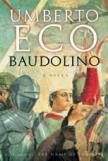A Quest of His Own
In his new novel, Umberto Eco, semiotics professor and the author of a number of essays and novels, offers a stylistic tour-de-force set in the latter part of the reign of Frederick Barbarossa, Holy Roman Emperor from 1155 to 1190.
The core of the novel is Baudolino—an unreliable narrator with a heart of gold, whose chief trait is a willingness to concoct a tall tale if it will serve a noble purpose. Baudolino lives in an articulate fantasy: “The problem of my life is that I’ve always confused what I saw with what I wanted to see.” The novel opens with Baudolino as an old man relating his life story to Niketas, a judge and historian at the court of Constantinople who is seeking safety with his family during the city’s fiery destruction in 1204 at the hands of rampaging Crusaders.
Baudolino recounts a remarkable, if not entirely believable, tale. Adopted as a kind of stepson by Frederick after Baudolino’s family gave him hospitality, Baudolino becomes a cherished protégé, the only one who speaks the truth to Frederick’s face, but also the one who makes up effective falsehoods to sustain Frederick’s interests or his own.
When Baudolino falls in love with Beatrice of Burgundy, Frederick’s wife, he writes love letters that he never sends, also composing her replies because he is so eager to receive them. Eventually he gives Beatrice both sides of the correspondence, so the letters actually become what they purported to be. As a semiotician, Eco delights in these shifts in the status of messages or signs. The novel is so rich in such shifts in the nature and transmission of messages that one wonders if Eco fashioned his protagonist’s name from today’s technical term “baud,” the variable rate at which data is transmitted by a computer. Baudolino does tell bawdy tales, but more importantly he functions in the novel as the chief transmitter of information, by written and spoken word.
Eco seasons his story with deft political commentary as the novel exposes the machinations and bureaucracy of Frederick’s court, the wiles of corrupt clergy and the seemingly unending cycle of human conflict and warfare. There are many moments in the novel that are reminiscent of Joseph Heller’s Catch-22 or Jonathan Swift’s Gulliver’s Travels. For example, in one instance simply renaming a town is enough to avert the wrath of Frederick’s advancing army.
Eco takes his reader through fascinating descriptions of the mechanics of siege warfare, the minutiae of cosmological arguments of the times—e.g., whether the earth is flat or spherical, whether a vacuum can exist or how to reconcile contradictory measurements given in Scripture for the Temple in Jerusalem. Eco is a historian of explanatory narratives, such as the documentation of false relics or the political justifications for Frederick’s title as Holy Roman Emperor. Having come up with some new story, Baudolino earns this praise from one of his companions: “Not bad.... It conceals and reveals at the same time. And it opens the path to the vortex of interpretation.” The reader is repeatedly immersed in the vortex of Baudolino’s version of history.
Knowing his love for Beatrice will never reach fulfillment, Baudolino sets out with an eccentric collection of comrades for the fabled realm of Prester John. The search for this kingdom is a quest for a utopian realm where Christian and Jew may live in peace and where wisdom governs the land.
The novel builds up to Baudolino’s account of how his sturdy band leads a local populace into battle against the White Huns, and he regales Niketas with vivid fantasies that would be right at home in a “Star Wars” film. Pouring into the fray are strange and exotic creatures—the one-legged skiapods, the blemmyae who lack heads, the panotians with huge ears that droop down to their knees and an assortment of pygmies, Nubians and giants. By this point Baudolino has come quite untethered from reality, raising questions about the veracity of his earlier narratives.
Eco also weaves a murder mystery into this latter part of the novel concerning whether Frederick drowned in the River Saleph, as history would have it, or whether he might have been murdered. As he did in The Name of the Rose, Eco provides an elegantly formulated and surprising solution.
William Weaver handles well the daunting task of translating Eco’s Italian into prose that is fluid but never florid. Consider the challenge of translating this description of the Sambatyon, a river that gushes rocks instead of water: “There were cataracts that plunged down from dozens of rocky eaves arranged like an ampitheater, into a boundless final vortex, an incessant retching of granite, an eddy of bitumen, a sole undertow of alum, a churning of schist, a clash of orpiment against the banks.”
Baudolino is a memorable Quixotic hero, confusing appearance and reality in his desire to do good. He summarizes his evolving philosophy of the imagination: “There is nothing better than imagining other worlds...to forget the painful one we live in. At least so I thought then. I hadn’t realized that, imagining other worlds, you end up changing this one.” Even in the 12th century, Eco seems to say, poets and storytellers were the unacknowledged legislators of the world.
This article also appeared in print, under the headline “A Quest of His Own,” in the November 11, 2002, issue.








